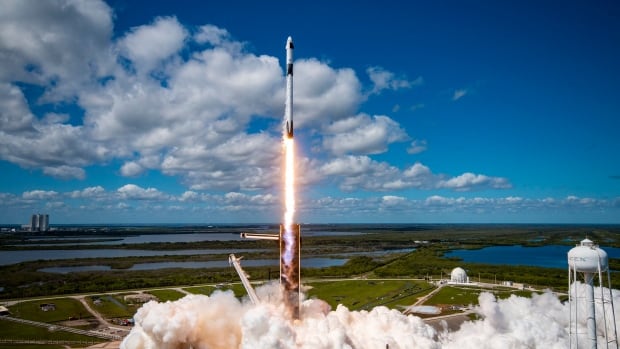
Last Thursday, a SpaceX Falcon 9 rocket blasted off from the Vandenberg Space Launch Complex in California with a payload of 20 Starlink satellites. And like the preceding 325 times before, the launch seemed to go off without a hitch: the rocket reached space and the first stage returned, landing on a drone ship in the Pacific Ocean.
But it soon became clear that all was not well with the second stage, the one that was to deploy the satellites. It appeared that some liquid was leaking from the spacecraft, forming ice crystals, with chunks periodically breaking free, being obliterated by heat coming from the nozzle of the engine behind it.
Initially, no word was mentioned about the anomaly on the broadcast feed. As is typical, the feed ended once the first stage landed, but it left many viewers wondering what to make of the ice build-up.
It turns out that, although the spacecraft was able to deploy its payload, the rocket was unable to put them in their intended orbit. Later, founder Elon Musk tweeted that it suffered a RUD, or a “rapid unscheduled disassembly” — SpaceX-speak for an explosion.
The satellites ended up falling out of orbit and burning up in our atmosphere the next day.
As a result, the U.S. Federal Aviation Administration (FAA) has grounded all SpaceX Falcon 9 rockets while it conducts an investigation.
According to an FAA statement received by Spaceflight Now, an online space news site, SpaceX has requested to resume launching the Falcon 9 rocket while the accident is being investigated.
“Usually these things don’t wrap up in a couple of weeks,” said Jordan Bimm, a space historian and professor of science communication at the University of Chicago.
“Usually, they take a couple months. And would the FAA be willing to expediate this given those factors? I don’t know, I think it depends on the nature of the anomaly, and kind of how dangerous it is, and how likely it is to have been reproduced in another vehicle.”
More than an inconvenience
While it may seem like nothing but a disruption in SpaceX’s plans to continuously launch hundreds more of Starlink satellites, the grounding has far bigger repercussions on future missions, including the first commercial spacewalk.
Polaris Dawn is a privately funded science mission that will use a Falcon 9 rocket and the company’s Crew Dragon spacecraft to conduct a science mission.
The mission is the first of its kind, with several science objectives, including flying 700 kilometres above Earth, making it the highest-altitude crewed flight since the Apollo moon missions. This orbit will take it past the protection of the Van Allen radiation belt. For comparison, the International Space Station (ISS) orbits roughly 400 kilometres above Earth.

The crew will also be the first to test SpaceX’s extravehicular activity spacesuits (EVA), upgraded from their intravehicular activity spacesuit (IVA). They will also test SpaceX’s Starlink laser-based communications in space, along with other health research.
The mission is supposed to launch on July 31.
After the announced grounding of the Falcon 9 rockets, Jared Isaacman, who is funding the mission, posted on social media that he is still confident in SpaceX.
SpaceX has an incredible track record with Falcon9. I can say from personal experience they are very transparent when issues arise. I have no doubt they will arrive at a cause quickly and ensure the most cost-effective and reliable launch vehicle keeps delivering payload to…
—@rookisaacman
But there are several more missions that could potentially face delays:
- The Arctic Satellite Broadband Mission — twin satellites designed to bring broadband mobile coverage in the Arctic — which was scheduled to launch this week.
- The Transporter-11 mission — a rideshare launch dedicated to hosting several different companies from around the world; it was originally scheduled to launch this month.
- Northrup Grumman’s Cygnus crew resupply mission that is scheduled for August 3.
- The Crew 9 mission to the ISS that is also scheduled to launch in the first half of August.
But Bimm said it’s more than that.
He’s concerned for astronauts Suni Williams and Butch Wilmore, who travelled to the ISS on in a test launch of a Boeing Starliner spacecraft. The capsule experienced several issues before docking with the space station and the astronauts have had their mission extended while Boeing investigates both in space and here on the ground.
Many space insiders have wondered if the pair are stranded on the station, and whether a SpaceX Crew Dragon could be sent up if they were.
“My thought … was Butch and Suni up there on the ISS and whether or not this would impact this sort of contingency planning that we’ve been sort of hearing whispers about, and peeps here and there — maybe what if they can’t come back on the Starliner,” Bimm said.
NASA and Boeing have vehemently denied that the pair are stranded, insisting the spacecraft is safe to bring them home.
Whatever the cause of the anomaly, SpaceX said it will co-operate with the investigation. However, it’s unclear how long it will take and what the repercussions will be for other missions down the line.
It’s a reminder that the pursuit of space travel is challenging.
“Space is hard and space is complex,” Bimm said. “We name rovers after space virtues, like Curiosity and Opportunity and Perseverance. I think another space virtue we’ve got to remember is patience. Spaceflight requires patience.”